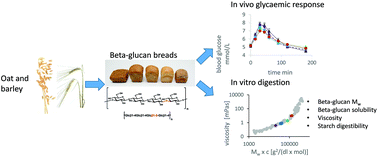At a high dose even partially degraded beta-glucan with decreased solubility significantly reduced the glycaemic response to bread†
Abstract
Cereal beta-glucan can reduce post-prandial glycaemic responses, which makes it an interesting ingredient to improve the health impact of bread, a staple food with a high glycaemic index (GI). Here we compare the ability of different wheat-based breads prepared with oat bran concentrate and barley flour and a Norwegian type of soft wrap (lompe) for their ability to reduce glycaemic responses in healthy adults. Both breads with the highest beta-glucan content (3.8 g per serving) significantly reduced peak blood glucose rise (PBGR), incremental area under the blood glucose curve (iAUC) and GI compared to wheat control regardless of beta-glucan Mw and solubility. At a medium dose of 1.7 g per serving breads with beta-glucan of high MW and solubility significantly lowered iAUC, but not GI or PBGR compared to white bread. In contrast to previous studies, no significant correlation between viscosity after in vitro digestion and any of the glycaemia variables was found. However, the amount of soluble beta-glucan per serving was inversely correlated with GI. Lompe had a similar medium GI (63) than the high dose beta-glucan breads (56 and 64). However, while “lompe” had significantly lower amounts of rapidly digestible starch, no differences in in vitro starch digestion were found between the different breads. Instead, increased local viscosity at the intestinal border (e.g. soluble beta-glucan interacting with the mucus layer), dilution of nutrients (higher water content and serving size) and/or reduced gastric emptying are proposed as potential explanations for the lower glycaemic responses to high dose beta-glucan breads.



 Please wait while we load your content...
Please wait while we load your content...